FORD B MAX 2012 1.G User Guide
Manufacturer: FORD, Model Year: 2012, Model line: B MAX, Model: FORD B MAX 2012 1.GPages: 256, PDF Size: 19.67 MB
Page 11 of 256
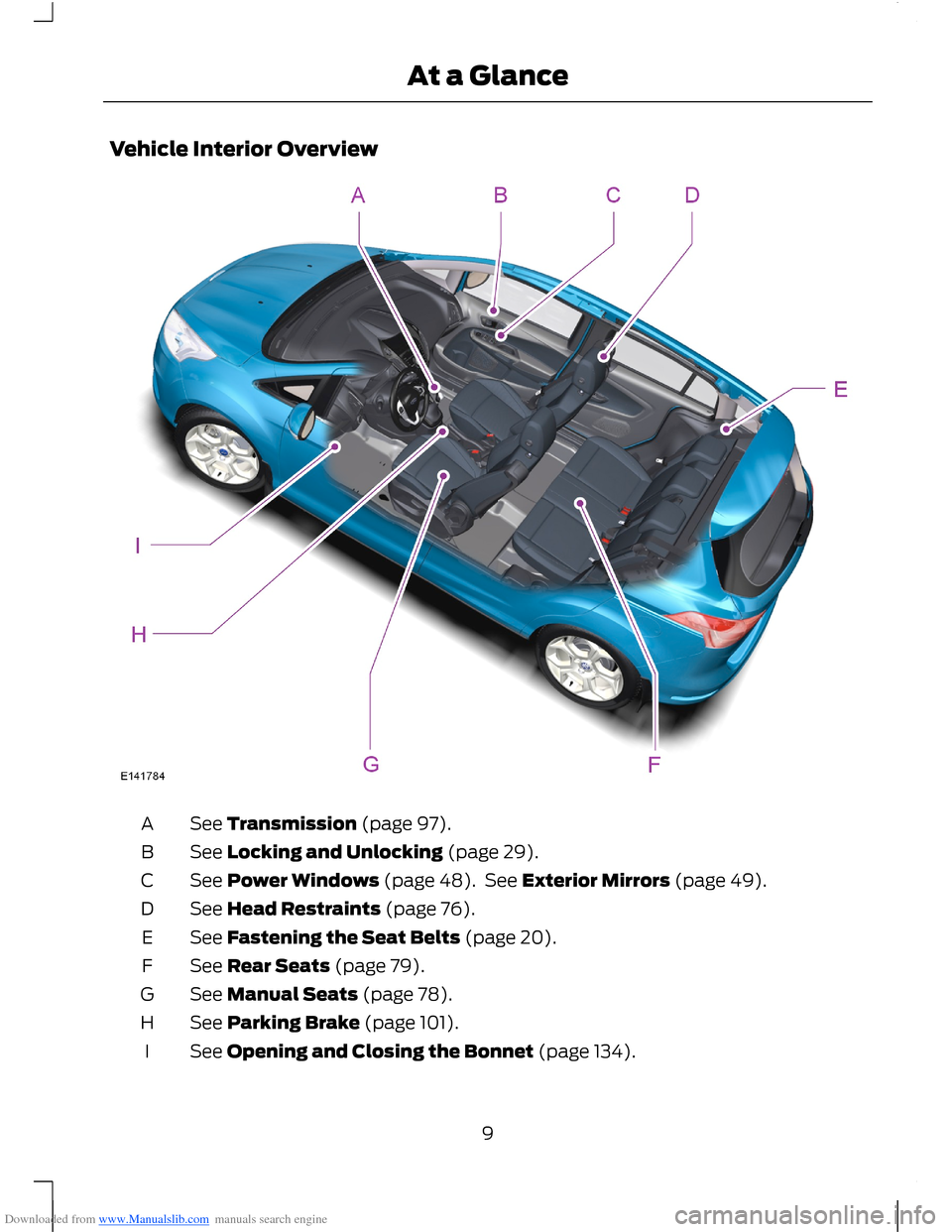
Downloaded from www.Manualslib.com manuals search engine Vehicle Interior Overview
See Transmission (page 97).A
See Locking and Unlocking (page 29).B
See Power Windows (page 48). See Exterior Mirrors (page 49).C
See Head Restraints (page 76).D
See Fastening the Seat Belts (page 20).E
See Rear Seats (page 79).F
See Manual Seats (page 78).G
See Parking Brake (page 101).H
See Opening and Closing the Bonnet (page 134).I
9At a Glance
Page 12 of 256
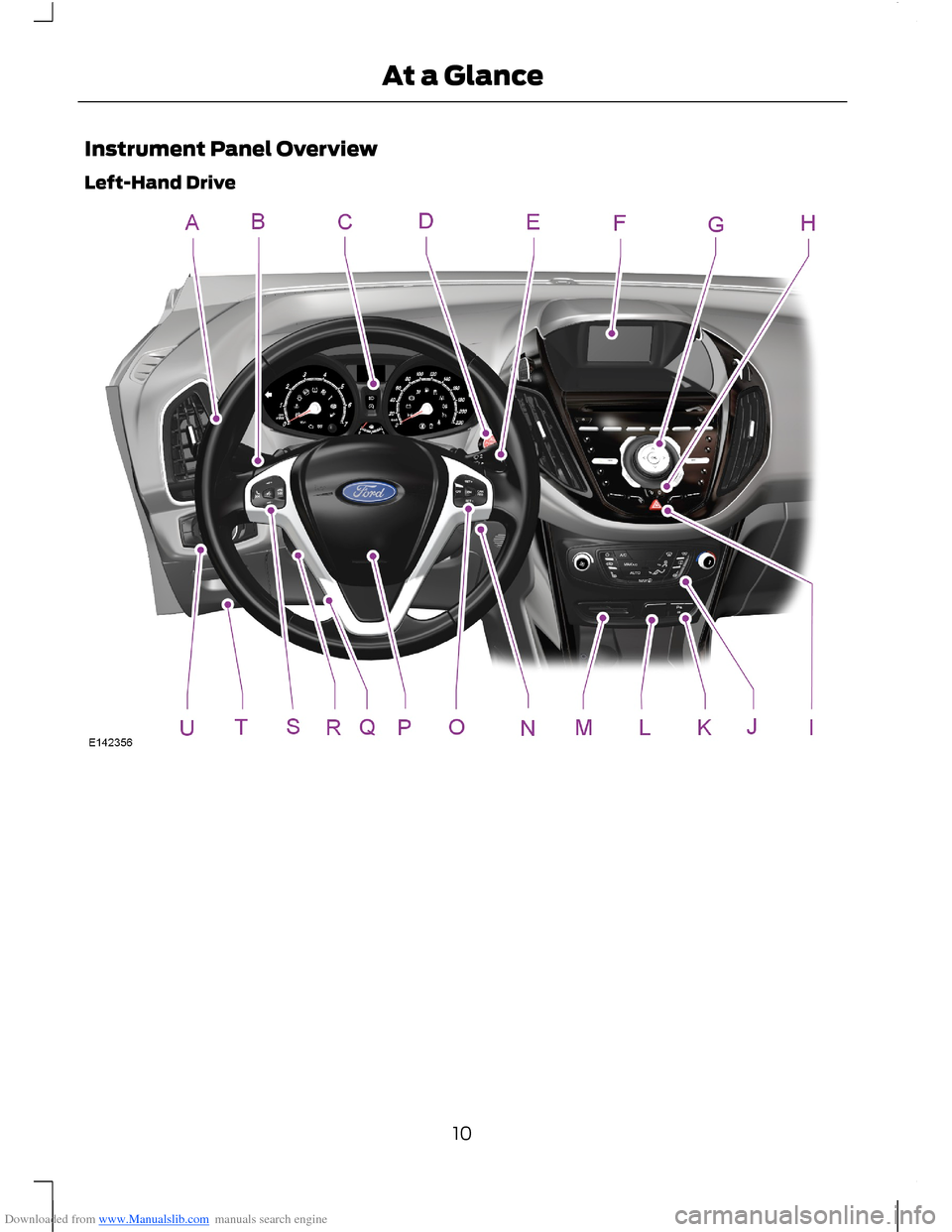
Downloaded from www.Manualslib.com manuals search engine Instrument Panel Overview
Left-Hand Drive
10At a Glance
Page 13 of 256
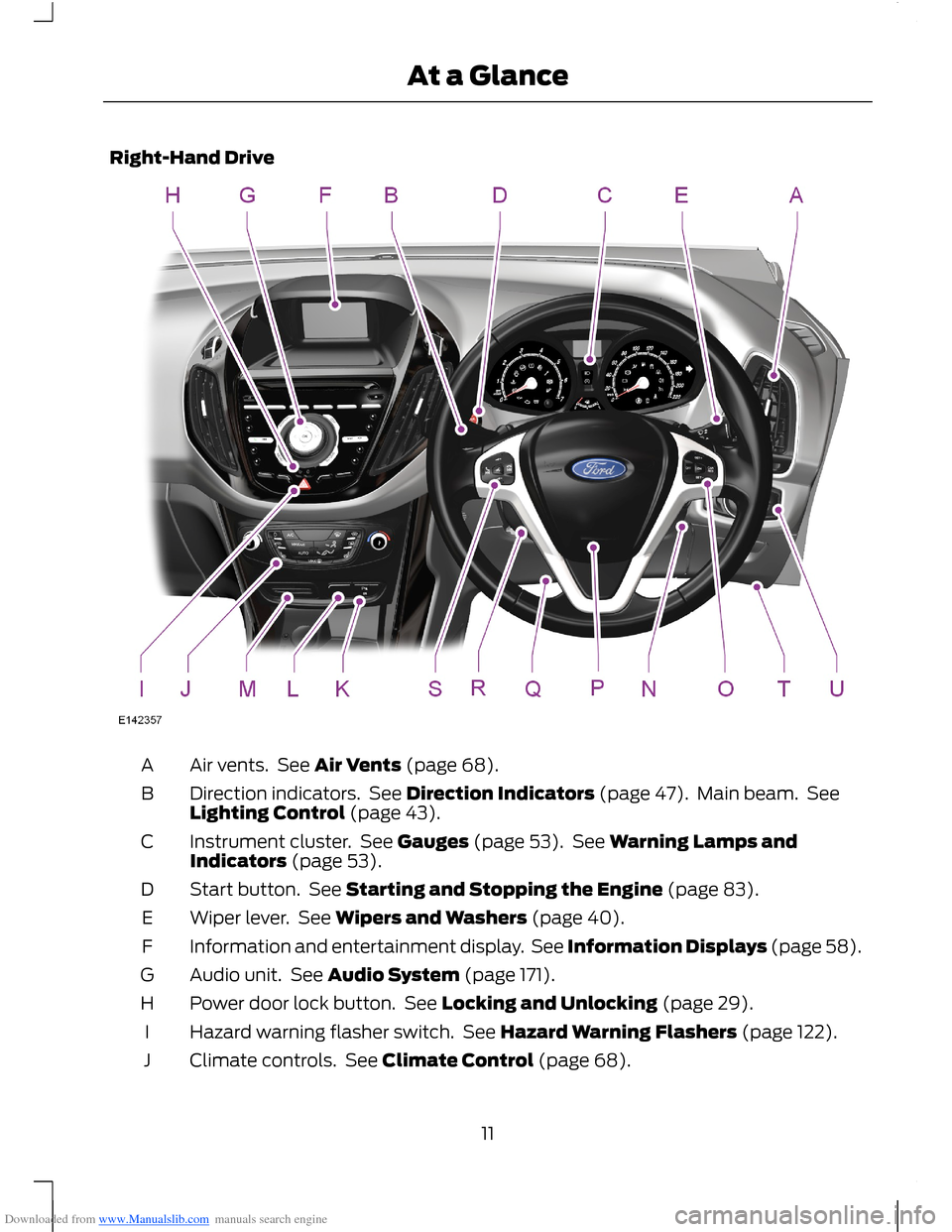
Downloaded from www.Manualslib.com manuals search engine Right-Hand Drive
Air vents. See Air Vents (page 68).A
Direction indicators. See Direction Indicators (page 47). Main beam. SeeLighting Control (page 43).B
Instrument cluster. See Gauges (page 53). See Warning Lamps andIndicators (page 53).C
Start button. See Starting and Stopping the Engine (page 83).D
Wiper lever. See Wipers and Washers (page 40).E
Information and entertainment display. See Information Displays (page 58).F
Audio unit. See Audio System (page 171).G
Power door lock button. See Locking and Unlocking (page 29).H
Hazard warning flasher switch. See Hazard Warning Flashers (page 122).I
Climate controls. See Climate Control (page 68).J
11At a Glance
Page 14 of 256
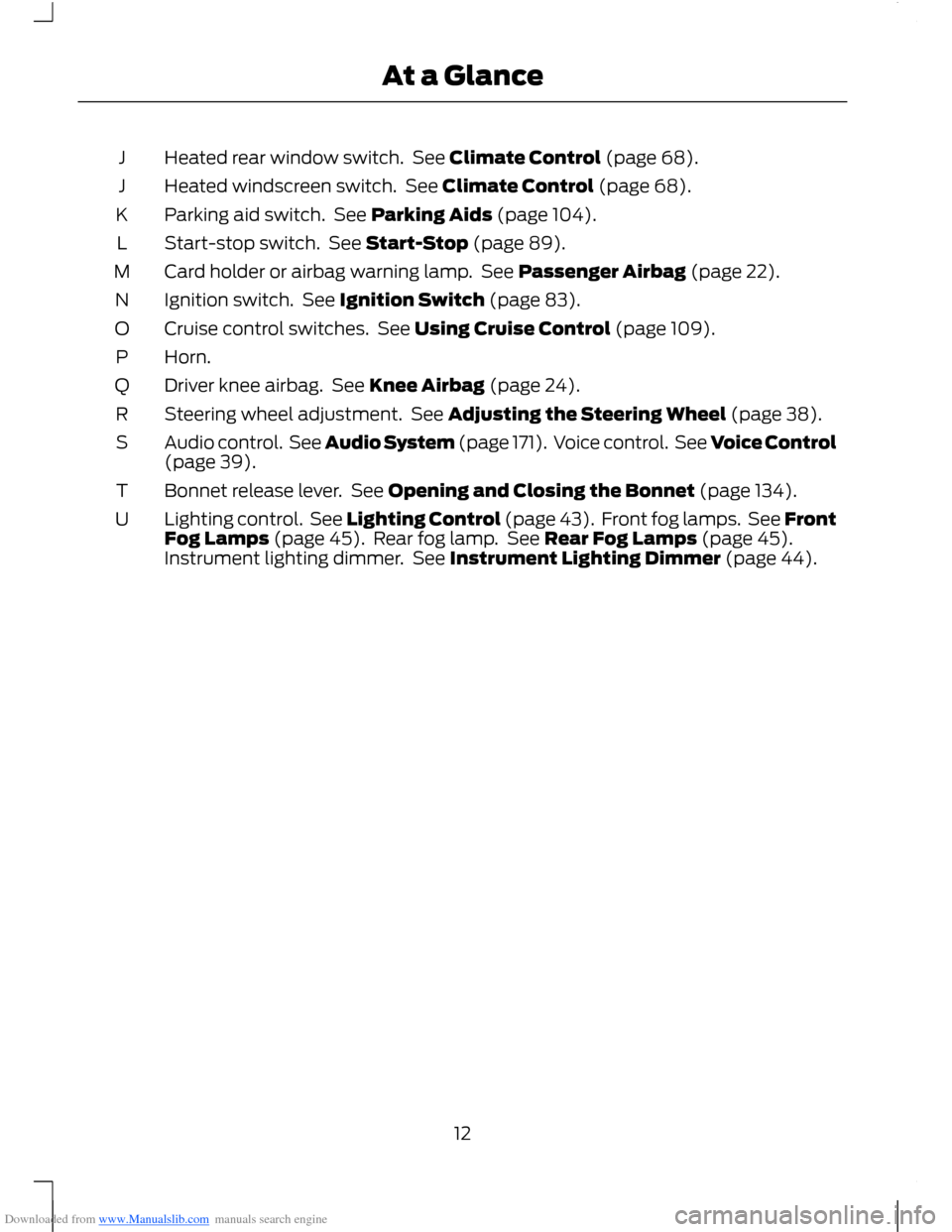
Downloaded from www.Manualslib.com manuals search engine Heated rear window switch. See Climate Control (page 68).J
Heated windscreen switch. See Climate Control (page 68).J
Parking aid switch. See Parking Aids (page 104).K
Start-stop switch. See Start-Stop (page 89).L
Card holder or airbag warning lamp. See Passenger Airbag (page 22).M
Ignition switch. See Ignition Switch (page 83).N
Cruise control switches. See Using Cruise Control (page 109).O
Horn.P
Driver knee airbag. See Knee Airbag (page 24).Q
Steering wheel adjustment. See Adjusting the Steering Wheel (page 38).R
Audio control. See Audio System (page 171). Voice control. See Voice Control(page 39).S
Bonnet release lever. See Opening and Closing the Bonnet (page 134).T
Lighting control. See Lighting Control (page 43). Front fog lamps. See FrontFog Lamps (page 45). Rear fog lamp. See Rear Fog Lamps (page 45).Instrument lighting dimmer. See Instrument Lighting Dimmer (page 44).
U
12At a Glance
Page 15 of 256
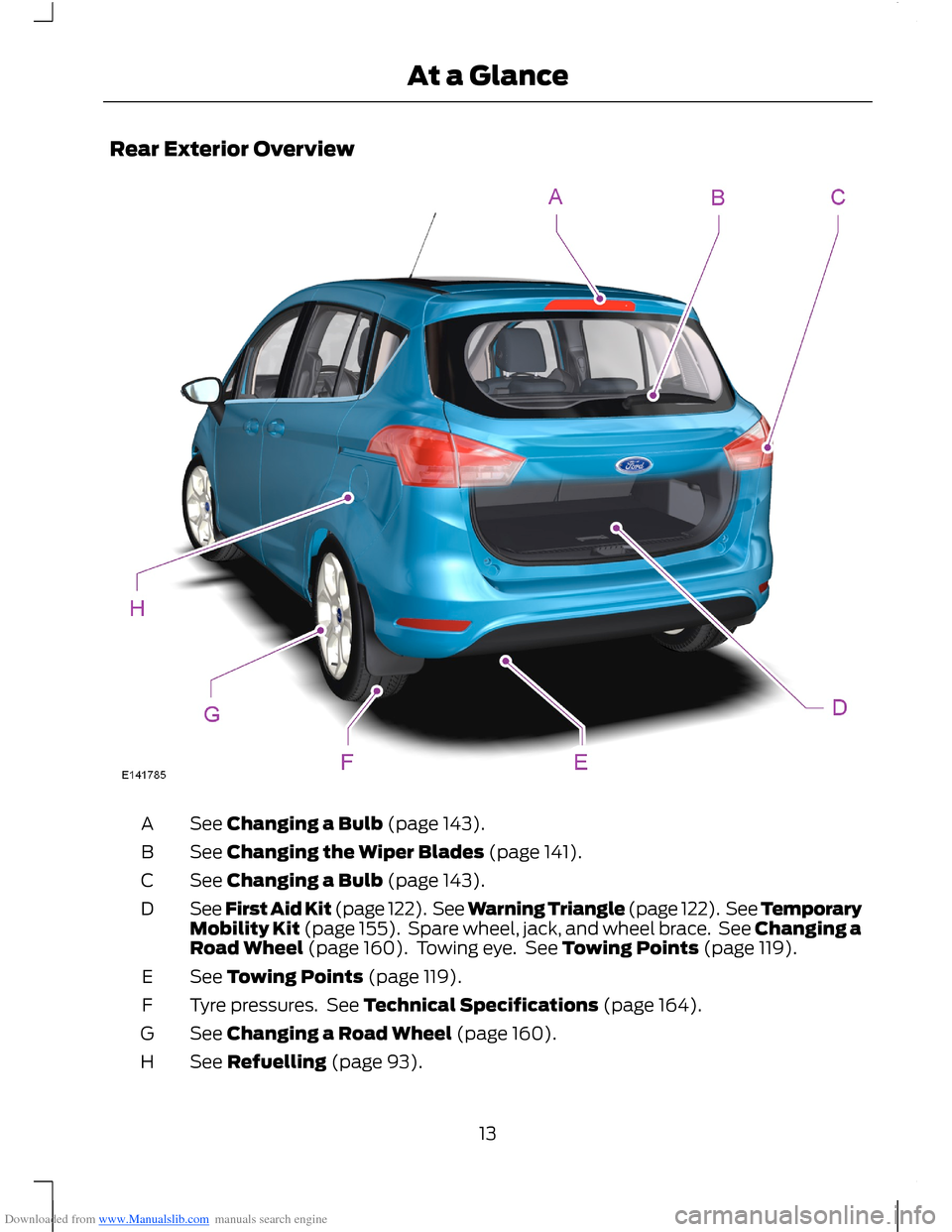
Downloaded from www.Manualslib.com manuals search engine Rear Exterior Overview
See Changing a Bulb (page 143).A
See Changing the Wiper Blades (page 141).B
See Changing a Bulb (page 143).C
See First Aid Kit (page 122). See Warning Triangle (page 122). See TemporaryMobility Kit (page 155). Spare wheel, jack, and wheel brace. See Changing aRoad Wheel (page 160). Towing eye. See Towing Points (page 119).
D
See Towing Points (page 119).E
Tyre pressures. See Technical Specifications (page 164).F
See Changing a Road Wheel (page 160).G
See Refuelling (page 93).H
13At a Glance
Page 16 of 256
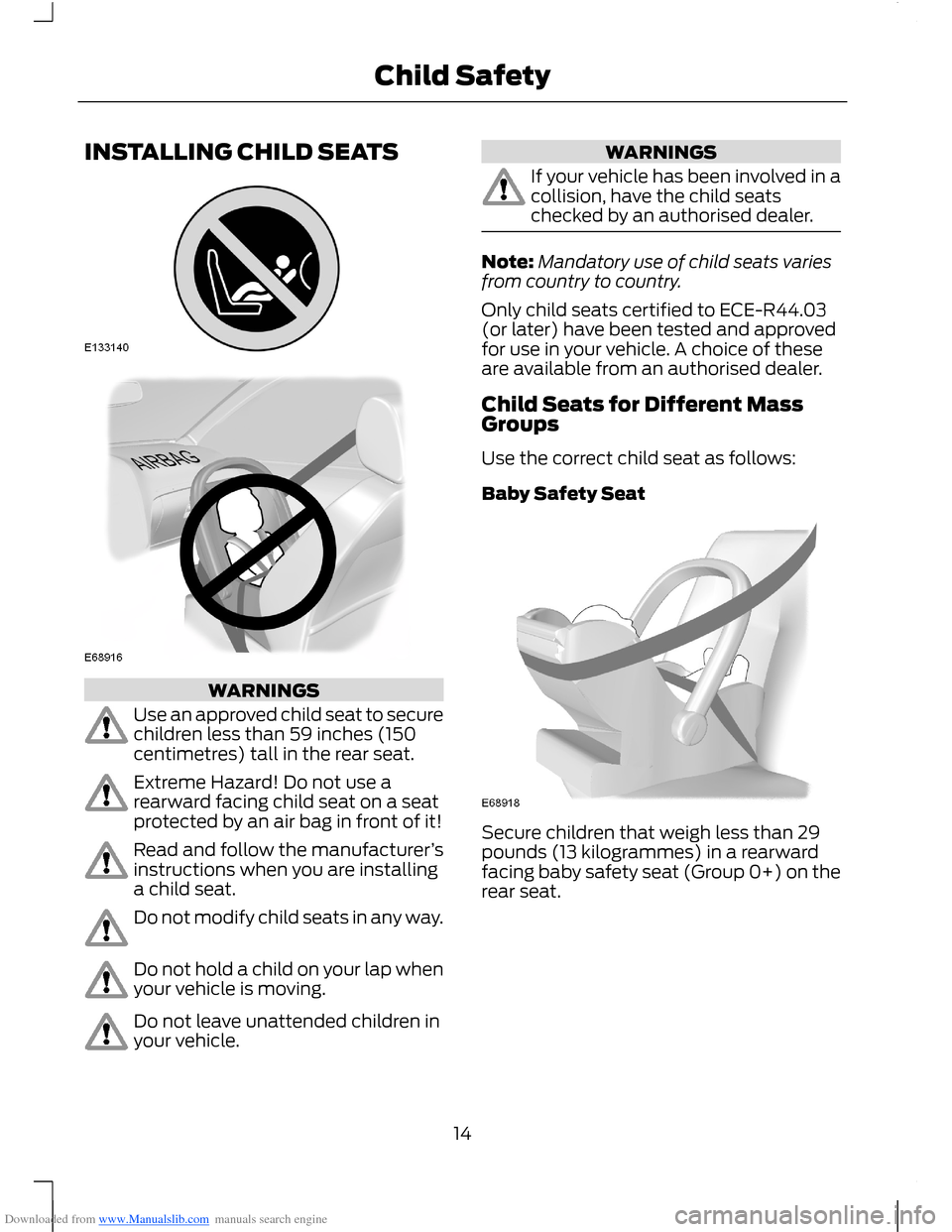
Downloaded from www.Manualslib.com manuals search engine INSTALLING CHILD SEATS
WARNINGS
Use an approved child seat to securechildren less than 59 inches (150centimetres) tall in the rear seat.
Extreme Hazard! Do not use arearward facing child seat on a seatprotected by an air bag in front of it!
Read and follow the manufacturer’sinstructions when you are installinga child seat.
Do not modify child seats in any way.
Do not hold a child on your lap whenyour vehicle is moving.
Do not leave unattended children inyour vehicle.
WARNINGS
If your vehicle has been involved in acollision, have the child seatschecked by an authorised dealer.
Note:Mandatory use of child seats variesfrom country to country.
Only child seats certified to ECE-R44.03(or later) have been tested and approvedfor use in your vehicle. A choice of theseare available from an authorised dealer.
Child Seats for Different MassGroups
Use the correct child seat as follows:
Baby Safety Seat
Secure children that weigh less than 29pounds (13 kilogrammes) in a rearwardfacing baby safety seat (Group 0+) on therear seat.
14Child Safety
Page 17 of 256
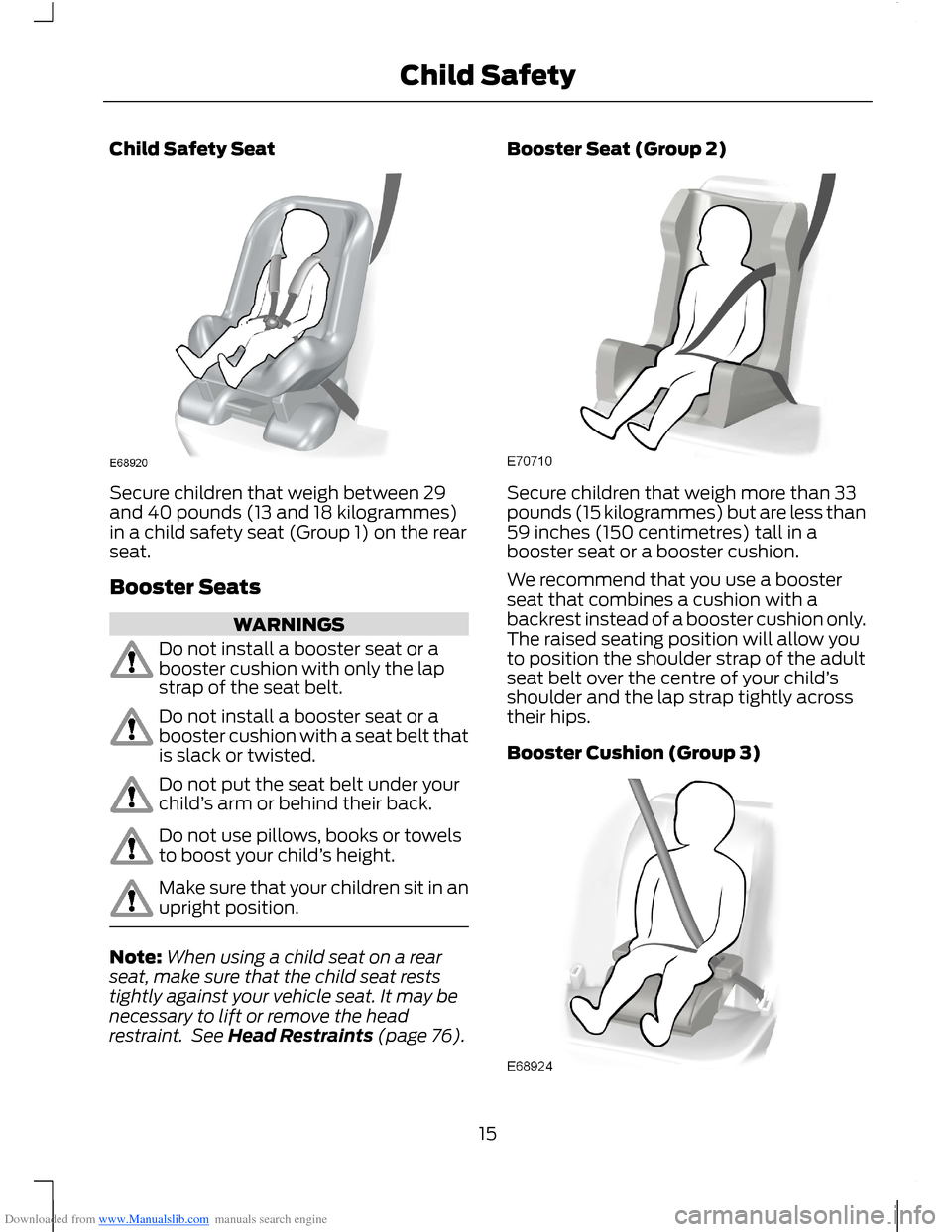
Downloaded from www.Manualslib.com manuals search engine Child Safety Seat
Secure children that weigh between 29and 40 pounds (13 and 18 kilogrammes)in a child safety seat (Group 1) on the rearseat.
Booster Seats
WARNINGS
Do not install a booster seat or abooster cushion with only the lapstrap of the seat belt.
Do not install a booster seat or abooster cushion with a seat belt thatis slack or twisted.
Do not put the seat belt under yourchild’s arm or behind their back.
Do not use pillows, books or towelsto boost your child’s height.
Make sure that your children sit in anupright position.
Note:When using a child seat on a rearseat, make sure that the child seat reststightly against your vehicle seat. It may benecessary to lift or remove the headrestraint. See Head Restraints (page 76).
Booster Seat (Group 2)
Secure children that weigh more than 33pounds (15 kilogrammes) but are less than59 inches (150 centimetres) tall in abooster seat or a booster cushion.
We recommend that you use a boosterseat that combines a cushion with abackrest instead of a booster cushion only.The raised seating position will allow youto position the shoulder strap of the adultseat belt over the centre of your child’sshoulder and the lap strap tightly acrosstheir hips.
Booster Cushion (Group 3)
15Child Safety
Page 18 of 256
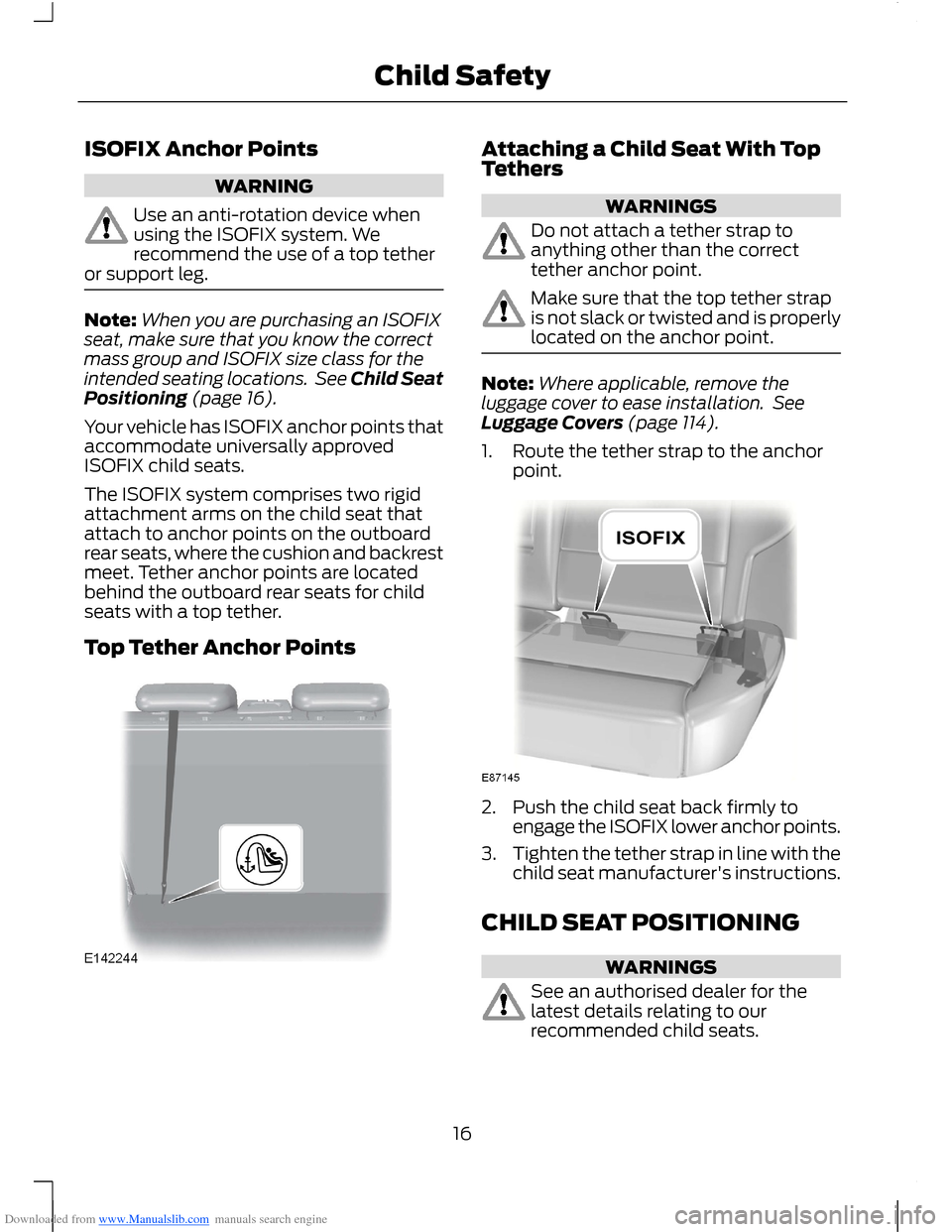
Downloaded from www.Manualslib.com manuals search engine ISOFIX Anchor Points
WARNING
Use an anti-rotation device whenusing the ISOFIX system. Werecommend the use of a top tetheror support leg.
Note:When you are purchasing an ISOFIXseat, make sure that you know the correctmass group and ISOFIX size class for theintended seating locations. See Child SeatPositioning (page 16).
Your vehicle has ISOFIX anchor points thataccommodate universally approvedISOFIX child seats.
The ISOFIX system comprises two rigidattachment arms on the child seat thatattach to anchor points on the outboardrear seats, where the cushion and backrestmeet. Tether anchor points are locatedbehind the outboard rear seats for childseats with a top tether.
Top Tether Anchor Points
Attaching a Child Seat With TopTethers
WARNINGS
Do not attach a tether strap toanything other than the correcttether anchor point.
Make sure that the top tether strapis not slack or twisted and is properlylocated on the anchor point.
Note:Where applicable, remove theluggage cover to ease installation. SeeLuggage Covers (page 114).
1.Route the tether strap to the anchorpoint.
2.Push the child seat back firmly toengage the ISOFIX lower anchor points.
3.Tighten the tether strap in line with thechild seat manufacturer's instructions.
CHILD SEAT POSITIONING
WARNINGS
See an authorised dealer for thelatest details relating to ourrecommended child seats.
16Child Safety
Page 19 of 256
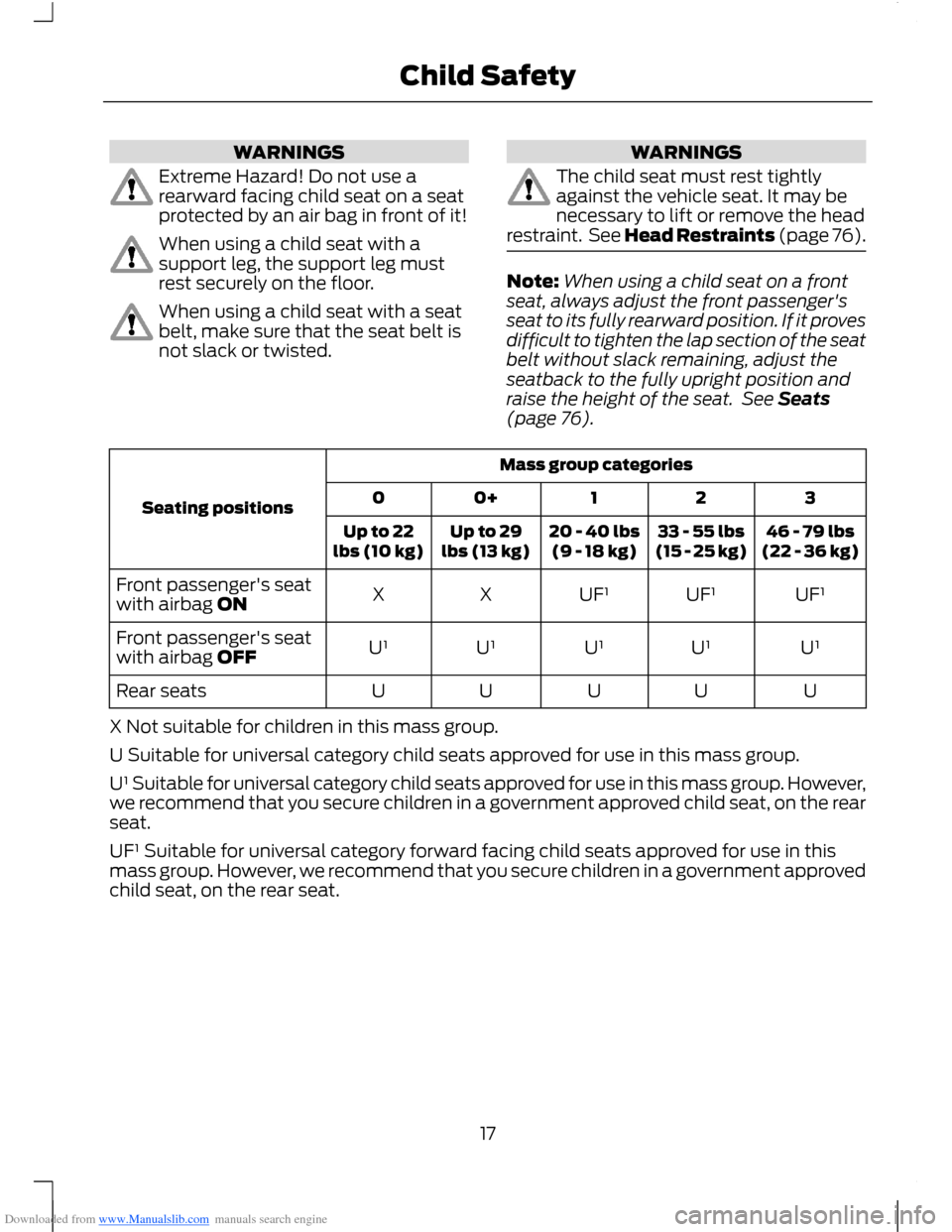
Downloaded from www.Manualslib.com manuals search engine WARNINGS
Extreme Hazard! Do not use arearward facing child seat on a seatprotected by an air bag in front of it!
When using a child seat with asupport leg, the support leg mustrest securely on the floor.
When using a child seat with a seatbelt, make sure that the seat belt isnot slack or twisted.
WARNINGS
The child seat must rest tightlyagainst the vehicle seat. It may benecessary to lift or remove the headrestraint. See Head Restraints (page 76).
Note:When using a child seat on a frontseat, always adjust the front passenger'sseat to its fully rearward position. If it provesdifficult to tighten the lap section of the seatbelt without slack remaining, adjust theseatback to the fully upright position andraise the height of the seat. See Seats(page 76).
Mass group categories
Seating positions3210+0
46 - 79 lbs(22 - 36 kg)33 - 55 lbs(15 - 25 kg)20 - 40 lbs(9 - 18 kg)Up to 29lbs (13 kg)Up to 22lbs (10 kg)
UF¹UF¹UF¹XXFront passenger's seatwith airbag ON
U¹U¹U¹U¹U¹Front passenger's seatwith airbag OFF
UUUUURear seats
X Not suitable for children in this mass group.
U Suitable for universal category child seats approved for use in this mass group.
U¹ Suitable for universal category child seats approved for use in this mass group. However,we recommend that you secure children in a government approved child seat, on the rearseat.
UF¹ Suitable for universal category forward facing child seats approved for use in thismass group. However, we recommend that you secure children in a government approvedchild seat, on the rear seat.
17Child Safety
Page 20 of 256
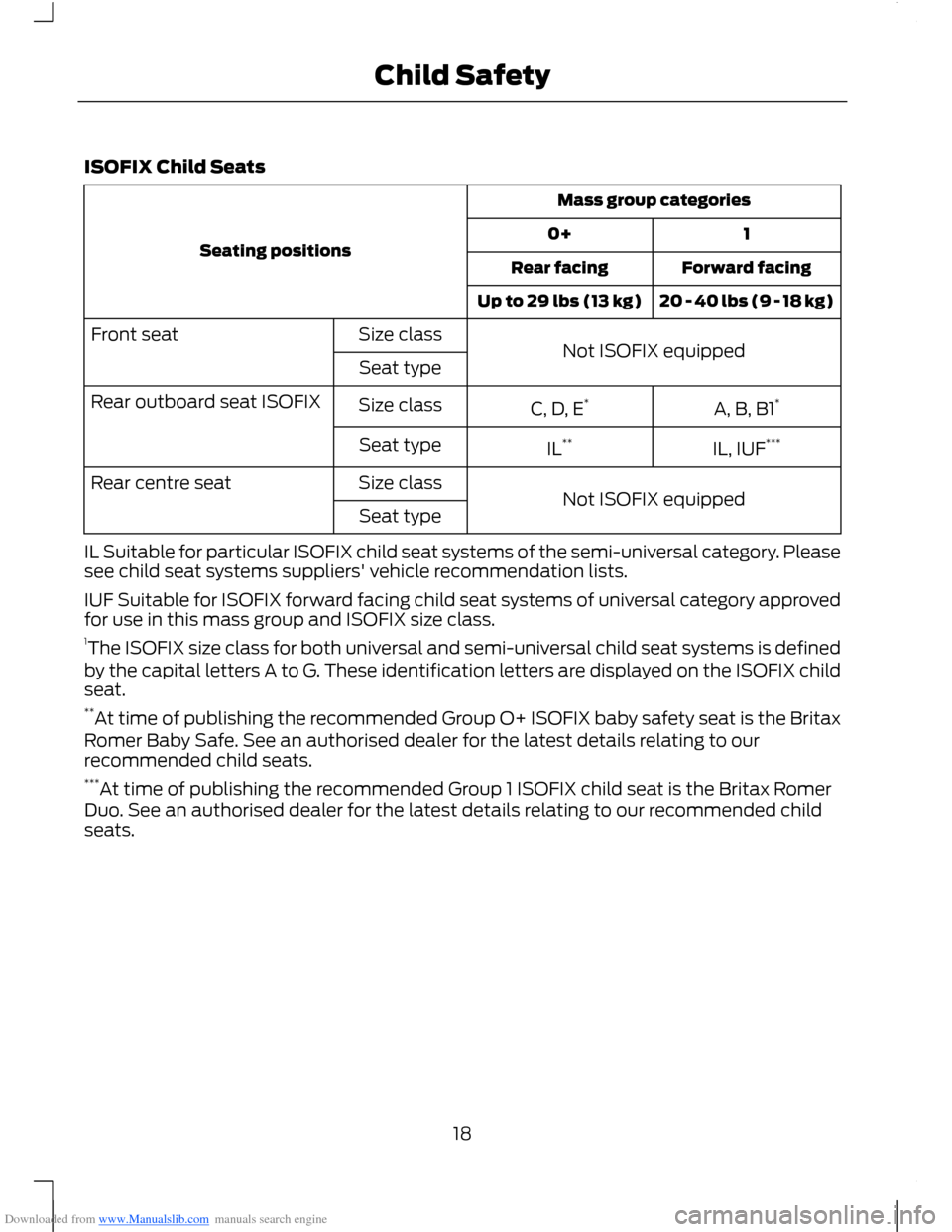
Downloaded from www.Manualslib.com manuals search engine ISOFIX Child Seats
Mass group categories
Seating positions10+
Forward facingRear facing
20 - 40 lbs (9 - 18 kg)Up to 29 lbs (13 kg)
Not ISOFIX equippedSize classFront seat
Seat type
A, B, B1*C, D, E*Size classRear outboard seat ISOFIX
IL, IUF***IL**Seat type
Not ISOFIX equippedSize classRear centre seat
Seat type
IL Suitable for particular ISOFIX child seat systems of the semi-universal category. Pleasesee child seat systems suppliers' vehicle recommendation lists.
IUF Suitable for ISOFIX forward facing child seat systems of universal category approvedfor use in this mass group and ISOFIX size class.1The ISOFIX size class for both universal and semi-universal child seat systems is definedby the capital letters A to G. These identification letters are displayed on the ISOFIX childseat.**At time of publishing the recommended Group O+ ISOFIX baby safety seat is the BritaxRomer Baby Safe. See an authorised dealer for the latest details relating to ourrecommended child seats.***At time of publishing the recommended Group 1 ISOFIX child seat is the Britax RomerDuo. See an authorised dealer for the latest details relating to our recommended childseats.
18Child Safety